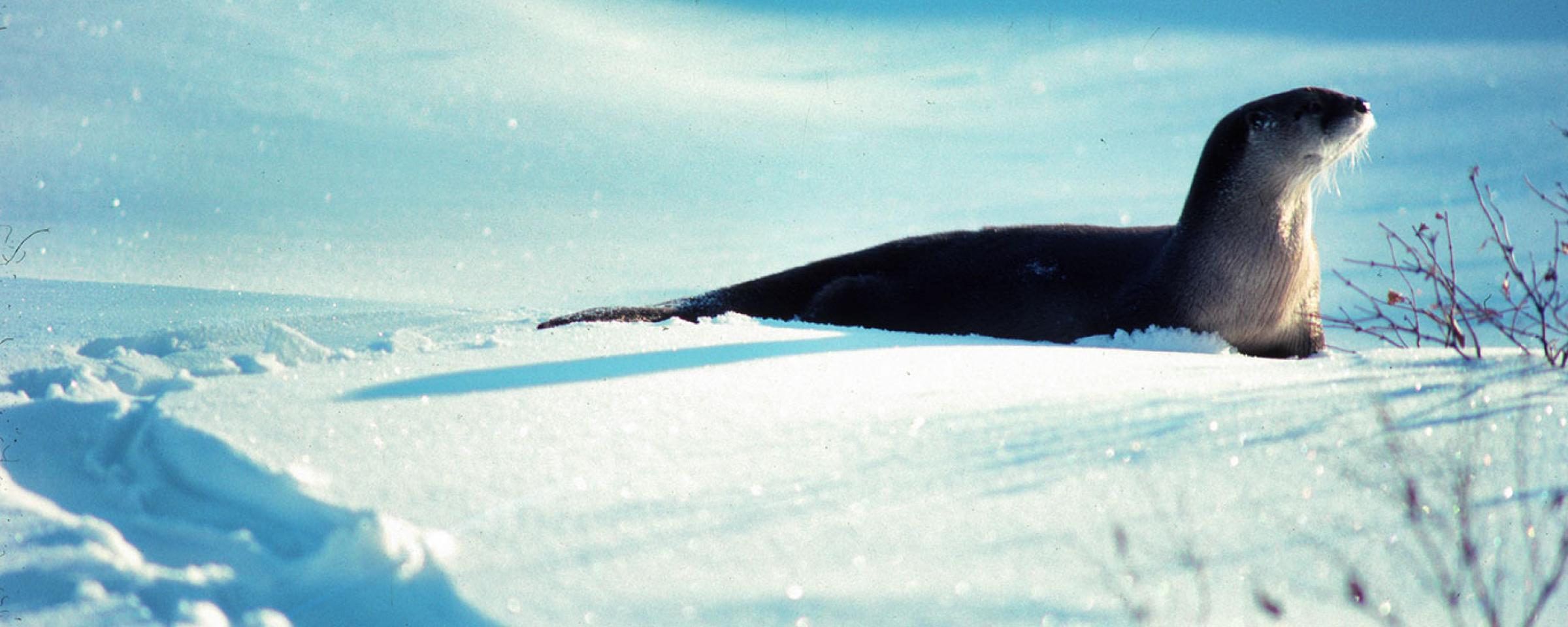
Game and Fish Considering River Otter Season
The North Dakota Game and Fish Department is considering a river otter season in 2017.
Stephanie Tucker, Department game management section leader and furbearer biologist, said the subject is up for discussion in late November and early December as a topic at fall district advisory board meetings, and again next spring when Department officials hold another round of advisory board meetings across the state.
“Data we have collected and research findings indicate that river otters have recolonized most areas of the state where they occurred historically, and they have inhabited the Red River Valley and its tributaries for about 15 years,” Tucker said. “When you gather years of research and study all the information, we believe a season is merited.”
Opening a harvest season would also facilitate an increase in available data, which would allow Game and Fish to better monitor the population. As of now, indications are a regulated trapping season would have a limited harvest of 15 otters.
“Currently we document at least 15 river otters that are killed annually in North Dakota,” Tucker said. “The true number of river otter mortalities per year is likely greater than that, and we are confident that adding a harvest season to those already taken by incidental trapping, or collisions with automobiles, will not be a detriment to the population.”
The taking of river otters would only involve trapping, not hunting. Tucker said river otters are a furbearer that is traditionally only trapped.
Additionally, Tucker said allowing trappers to keep those river otters that are already caught incidentally – typically in beaver traps – is a benefit of opening a trapping season.
“It is desirable to allow people to keep the pelts of those that are killed each year,” Tucker said. “By allowing people to hunt river otters, this benefit would be lost.”
The investigation into a possible river otter trapping season is similar to the process that Game and Fish officials followed to pursue a fisher trapping season.
In 2011, Tucker reported that research findings indicated that fishers had recolonized areas of the state where they historically occurred, and perhaps had even expanded.
Fishers were historically found in northeastern North Dakota, but considered extirpated from the state by the early 1900s. Tucker said verified reports of fishers began increasing in the late 1990s.
The first fisher trapping season was held in 2011. A limited, six-day season for these furbearers continues today for North Dakota residents east of U.S. Highway 281 and North Dakota Highway 4. The limit is one animal per trapper per season.
River Otters in North Dakota
River otters were never abundant in North Dakota, though historically they were found in major rivers and streams throughout the state, and were likely more common in the northeast.
Like beavers and other furbearers that were the target of trappers during the late 1700s and into the mid-1800s, otters were mostly gone from the state by the early 1900s.
The state first prohibited harvest of river otters in 1909. There was an open season again in 1919 and 1920, but they have been protected ever since.
River otters live in burrows near water. They are active in winter, using ice holes to surface and breathe. They hunt at night and feed on fish, amphibians, turtles and crayfish.

Surveys indicate that otters are recolonizing rivers and streams in North Dakota, with their primary distribution again along the Red River and its tributaries. This is not unexpected, as the closest established populations are found in northern Minnesota and southern Manitoba. Verified otter reports are predominantly from eastern North Dakota as well. From July 1, 2015 through June 30, 2016, Game and Fish recorded 29 reports of river otters, and 22 of those were verified. Nine came from Grand Forks County, while Traill, Ransom, Pembina, Steele, Griggs, Stutsman, Walsh, Nelson and Wells also had at least one verified otter report.
Most of the verified reports came in from fur harvesters who had incidentally captured otters in traps set for other species, primarily beavers.
Potential Otter Season Information
- Would open statewide November 27, 2017 and continue through March 15, 2018. Timing coincides with when pelts are at their prime.
- Season quota of 15. Once the quota is reached the season would close immediately.
- Limit of one river otter per season. Trappers would have to contact the local game warden or a Department field office within 12 hours of the harvest to have their otter tagged.
- Otters must be tagged. River otters are listed under Appendix II of the Convention on International Trade of Endangered Species (CITES). In order to sell/export a river otter out of state, the U.S. Fish and Wildlife Service requires that those pelts be “CITES tagged.” Additionally, mandatory tagging of river otter pelts is required to be consistent with other states’ regulations, and facilitate collection of their carcasses, from which biological data is collected to monitor population trends.
- Only river otters taken by Game and Fish, U.S. Department of Agriculture Wildlife Services or private landowners in defense of livestock or personal property do not count toward the quota.
